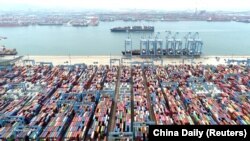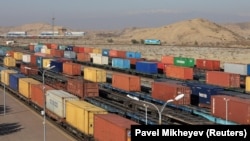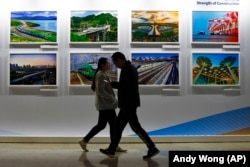
Welcome back to the China In Eurasia briefing, an RFE/RL newsletter tracking China’s resurgent influence from Eastern Europe to Central Asia.
I’m RFE/RL correspondent Reid Standish and here’s what I’m following right now.
The Kremlin’s invasion of Ukraine has upended Russia’s importance as an overland shipping route along China’s Belt and Road (BRI), forcing Beijing to pursue alternatives in Central Asia and the Caucasus, I reported here.
Finding Perspective: The main alternative is the roughly 6,500-kilometer network of roads, railroads, and ports stretching across Kazakhstan, the Caspian Sea, Azerbaijan, Georgia, Turkey, and into Europe known as the Trans-Caspian International Transport Route or the Middle Corridor of the BRI.
Russia became the preferred route for Chinese freight carriers and cargo shippers due to fewer customs checks and lower costs, accounting for 68 percent of westbound traffic and 82 percent of eastbound traffic in 2021 between China and the European Union.
But with many large companies and shipping firms unable or unwilling to rely on transport through Russia due to sanctions, Moscow’s February invasion is changing that.
According to the Trans-Caspian International Transport Route Association, cargo shipments across Central Asia and the Caucasus are expected to reach 3.2 million metric tons in 2022, a sixfold increase over the previous year.
In addition to buy-ins from Chinese companies and the state, local governments along the route are moving to capitalize on the shift with a flurry of meetings, pledges, and formal agreements over the past few months between officials from Azerbaijan, Georgia, Kazakhstan, Romania, and Turkey.
That trend looks set to continue over the summer, as well, with the Uzbek and Georgian foreign ministers inking a two-year cooperation pact on July 19 to improve and develop more transportation infrastructure to help move goods east and west on their way between China and Europe.
Why It Matters: As Andreea Brinza, vice president of the Romanian Institute for the Study of the Asia-Pacific, told me, the shift to the Middle Corridor highlights the fluid nature of the BRI and how quickly investment can materialize when it is motivated by necessity on the Chinese side.
But the shocks from the war are unlikely to stop there, and Beijing won’t be satisfied with only building up one alternative as it adapts away from relying heavily on shipping through Russia, Emil Avdaliani from the European University in Tbilisi and director of Middle East studies at the Georgian think tank Geocase told me.
“We are in the process of the BRI adapting to [big] changes, namely, [the] near total halt of transit through Russia,” he said. “Several interlinked developments have taken place that show [major] shifts in Eurasian connectivity patterns are [under way].”
Read More
● For another look at how the war in Ukraine is affecting the BRI and Chinese investment in Russia, read this investigation from April by my colleagues at RFE/RL’s Tatar-Bashkir Service.
● In a wide-ranging interview with Foreign Policy magazine, former U.S. National Security Council official Fiona Hill offered some interesting observations on the China-Russia relationship, including future dependence on Beijing, cooperation in disinformation, and whether China is reassessing its partnership with Moscow.
Expert Corner: Xi’s Victory Lap in Xinjiang
Readers asked: “Chinese President Xi Jinping recently made his first trip to Xinjiang in eight years. The last visit involved a military escort, and this time he was greeted by clapping crowds. What was the message of this trip and who was its audience?”
To find out more, I asked Bradley Jardine, a fellow at the Wilson Center’s Kissinger Institute on China and the United States:
“Xi’s unannounced visit to Xinjiang was designed to project an image of stability and progress both internationally and domestically. The central emphasis was on Xi's vision of a Han-centric national identity for the Chinese state -- a cornerstone of his domestic agenda. This nationalist policy has been pursued through brutal ‘harmonization’ campaigns involving mass surveillance, reeducation, and cultural desecration designed to Sinicize aspects of minority cultures and make them more consistent with Han aesthetics and values.
“The most obvious physical example of these policies is the destruction of mosques and attempts to make Islamic architecture conform with Han Chinese tradition. It is no coincidence that Xi Jinping chose to visit ancient Han Empire ruins in Xinjiang – echoing a propaganda talking point that the region has been part of Chinese state projects for at least 2,000 years. This was a move designed to show international audiences that the Communist Party is consolidating its grip on Xinjiang and that the region will remain under Beijing's control.”
Do you have a question about China’s growing footprint in Eurasia? Send it to me at StandishR@rferl.org or reply directly to this e-mail and I’ll get it answered by leading experts and policymakers.
Three More Stories From Eurasia
1. Montenegro’s Highway Opens At Last
After eight years of delays and controversy, the first 41-kilometer stretch of Montenegro’s Chinese-financed and built Bar-Boljare Highway opened on July 13, my colleague Slavica Brajovic from RFE/RL’s Balkan Service reported.
The Details: The highway was opened by a symbolic push of a button by Montenegro’s leading officials, with Prime Minister Dritan Abazovic saying that “Montenegro, through this project, together with the port of Bar, will be one of the important routes in the transit flows of the Balkans.”
Also speaking at the opening ceremony outside of the capital, Podgorica, was Hua Jafang, the chargé d'affaires at the Chinese Embassy in Montenegro, who called the project “a monumental success in the field of traffic infrastructure.”
The project was marred in scandal over the nearly $1 billion loan borrowed from the Export-Import Bank of China in 2014, which was widely seen as over-budget and contributed to the Balkan country’s soaring national debt, which it was unable to pay until refinancing thanks to several Western banks.
The state-owned China Road and Bridge Corporation built the highway but suffered multiple delays that pushed the project back.
While the ceremony marked the opening of the initial section of the road, the entire highway is supposed to total 163 kilometers and there are currently no plans or financing under way for the remaining portions.
2. Ukraine's Homegrown Response To Chinese Detection Tech
A team of volunteer Ukrainian drone operators working with the military told RFE/RL they’ve developed their own way to bypass a controversial piece of Chinese technology that they say Russian forces have been using to target Ukrainian soldiers.
What You Need To Know: AeroScope, the tech in question, is a surveillance system made by DJI, the preeminent Chinese drone producer, and is able to detect the flight path of other DJI-branded devices and pinpoint exactly where the drone’s operator is standing.
One member of Aerorozvidka, an organization of Ukrainian drone specialists working with the military, confirmed to RFE/RL that Russian troops have been using the system to find and kill Ukrainian operators during the war.
DJI says AeroScope was developed only to be used by law enforcement and, in response to reports of its use on the battlefield, the company suspended sales of its drones and other tech to both Russia and Ukraine in April.
But Aerorozvidka says AeroScope is still in use, so it has phased out DJI drones and has developed its own homegrown model that can circumvent the Chinese tech.
3. China, Russia, and An Anti-War Cartoon
The popular Russian-language cartoon Masyanya is trending on YouTube after a new episode satirized the Kremlin’s justification for its war in Ukraine by depicting China invading Russia in order to save it from fascism. You can watch Current Time’s video report on it here.
What It Means: Masyanya, which was created by Russian-Israeli artist Oleg Kuvaev, has a strong antiwar message and shows scenes of Russian cities ostensibly destroyed by Chinese bombs and tanks.
In an interview, Kuvaev -- who has been an outspoken critic of the war in Ukraine -- said he wanted to ridicule Moscow’s pretext for its invasion and use the episode to target people in Russia who support the war in order to undercut Kremlin propaganda about it.
“I don’t understand how [people] can be so stupid, so zombified, so distrustful of what they see, and unwilling to know,” he said. “Because if they wanted to know, they could [easily] find out.”
Kuvaev had published three episodes of the cartoon about the war and it has faced censorship inside Russia by the authorities. The most recent episode has already garnered more than 3 million views on YouTube.
Across The Supercontinent
Life After The Camps: Zhazira Asenqyzy was a well-known ethnic Kazakh poet, writer, and businesswoman in Xinjiang, but after being thrown into one of Xinjiang's notorious internment camps in 2017, she’s struggling to rebuild her life. My colleagues Nurtai Lakhanuly and Farangis Najibullah profile her in a recent article.
Xi Calling: China has invited German Chancellor Olaf Scholz, French President Emmanuel Macron, Italian Prime Minister Mario Draghi, and Spanish Prime Minister Pedro Sanchez to Beijing to meet with Xi in November, the South China Morning Post reports.
According to the report, the proposed date would likely be right after the 20th party congress, expected to be held in October, and there’s no word yet if the invitation has been accepted.
Tapped Out: Gas exports to China from Kazakhstan’s Sarybulak field in the Zaisan basin have been suspended after regional authorities said the reserves have been depleted, Khadisha Akayeva from RFE/RL’s Kazakh Service reported.
Blocked: China is asking United Nations human rights chief Michelle Bachelet to bury a highly anticipated report on human rights violations in Xinjiang, according to a Chinese letter seen by Reuters.
Detained in Germany: Yilisen Aierken, an ethnic Kazakh asylum seeker from Xinjiang who fled Ukraine after Russia’s invasion, has been detained in Germany for illegally crossing a border, RFE/RL’s Kazakh Service reported.
I interviewed Aierken and stayed in contact with him back in early March as he fled Ukraine and applied for asylum in Poland. But he later left Poland and has been detained several times in other EU countries while his legal status remains uncertain.
One Thing To Watch
A worsening meltdown in China’s debt-laden property market is at the heart of a deepening economic problem for the country that several commentators have said is “giving off strong Lehman Brothers vibes,” in reference to the U.S. firm that helped trigger the 2008 financial crisis.
Earlier this month hundreds of depositors protested in front of the People’s Bank of China in Henan demanding access to their frozen life savings held in rural banks. The next day, tens of thousands of homeowners threatened to stop paying mortgages on scores of unfinished housing projects they had purchased.
China’s economy is facing a dangerous cocktail of stalling growth, high unemployment, spreading mortgage payment strikes, and continued lockdown over COVID-19 that could have serious social and political consequences for China’s leadership and its economy.
The property market is at the heart of the financial woes, with a toxic $300 billion debt pile unleashed by last year’s collapse of the giant developer Evergrande, which analysts say is slowly infecting the wider Chinese economy.
That’s all from me for now. Don’t forget to send me any questions, comments, or tips that you might have.
Until next time,
Reid Standish
If you enjoyed this briefing and don't want to miss the next edition, subscribe here. It will be sent to your in-box on the first and third Wednesdays of each month.









